Back to Journals » Journal of Blood Medicine » Volume 12
Usage and Acceptability of the Wateen Application Among the Population of Saudi Arabia
Authors AlOtaibi N , Alsaleebi S, Alanezi F , Alhodaib H , AlThani B , Aljabri D , Alsalman D , Al-Fayez A , Saadah A, Alrawiai S , Alyousif N, Alanzi T
Received 12 July 2021
Accepted for publication 15 September 2021
Published 1 October 2021 Volume 2021:12 Pages 863—873
DOI https://doi.org/10.2147/JBM.S328981
Checked for plagiarism Yes
Review by Single anonymous peer review
Peer reviewer comments 3
Editor who approved publication: Dr Martin H Bluth
Noot AlOtaibi,1 Sarah Alsaleebi,2 Fahad Alanezi,3 Hala Alhodaib,4 Bashair AlThani,5 Duaa Aljabri,1 Demah Alsalman,1 Asma Al-Fayez,1 Amjad Saadah,1 Sumaiah Alrawiai,1 Norah Alyousif,6 Turki Alanzi1
1Department of Health Information Management and Technology, College of Public Health, Imam Abdulrahman Bin Faisal University, Dammam, Saudi Arabia; 2Blood Bank, King Fahad Specialist Hospital, Dammam, Saudi Arabia; 3Community College, Imam Abdulrahman Bin Faisal University, Dammam, Saudi Arabia; 4Department of Community Health Sciences, College of Applied Medical Sciences, King Saud University, Riyad, Saudi Arabia; 5College of Business Administration, Imam Abdulrahman Bin Faisal University, Dammam, Saudi Arabia; 6Information Technology Department, Saudi Aramco, Dhahran, Saudi Arabia
Correspondence: Turki Alanzi
Department of Health Information Management and Technology, College of Public Health, Imam Abdulrahman Bin Faisal University, King Faisal Road, Dammam, 31441, Saudi Arabia
Tel +966 133331211
Email [email protected]
Purpose: The main objective of this research was to investigate the opinion of the population of Saudi Arabia on the use and acceptability of the Wateen application.
Methods: This research was a quantitative cross-sectional study in which an online questionnaire was distributed among the target population who were healthy people over 18 years of age that had used or known about the Wateen application. A total of 352 participants responded to the questionnaire. The data collection was carried out between November and December 2020. A basic descriptive statistical analysis was used to analyze the data.
Results: The participants had used the Wateen app to follow the donation record, as a reminder of donation dates, to find lists and blood bank locations, to request blood donation, and to find donation requests on social media. After receiving the blood donation request from the Wateen app, majority of the respondents felt encouraged, motivated, and educated to donate blood, and about blood donation, respectively. Participants also indicated that the application helped them to find donors. Besides, majority of the respondents stated that the Wateen app had reduced the gap between blood donors and the need for blood. However, few participants expressed that they had not received or observed a post about the Wateen application on social media networks.
Conclusion: The results of this research indicated that there is a general acceptance of the use of the Wateen app among the participants of this study. However, the importance of the Wateen app needs to be further advertised so that it can be used in the blood donation process in all regions of Saudi Arabia. In this way, the people of Saudi Arabia will be more aware of the importance of the Wateen app in the blood donation process, and the goal of the Ministry of Health of bridging the gap between donation centers and blood donors could be achieved.
Keywords: Wateen application, blood donation, m-health, Saudi Arabia, user acceptability
Introduction
Blood donation is a humanitarian, altruist, noble, and solidary act supported by all health organizations in the world.1–3
Blood transfusion saves lives and improves health … Providing safe and adequate blood should be an integral part of every country’s national health care policy and infrastructure.2
In this regard, statistics from the World Health Organization have indicated that 118.5 million blood donations were collected worldwide in 2020.2 Forty percent of these donations were collected in high-income countries where 16% of the world’s population lives.2
With the advancement of information and communication technologies, new technological tools such as social networks and applications have been used for the blood donation process on a global scale.1,3–12 However, finding blood donors is a challenging problem for blood banks in almost all countries.13 In this sense, some specific applications have been developed such as the Blood application of the Red Cross, the Blood Donor Finder application of Neologix, BLOODR, and others.4,7,11,13 The Red Cross Blood app has been used to locate and make appointments with blood banks and donation centers, the Blood Donor Finder allows users to find the closest donors when they need a blood donation, and BLOODR provides proper communication between patients and donor regarding the donation requirements.4,7,13 Also, Ouhbi et al carried out a systematic search of blood donation applications available in Apple apps, Google Play, BlackBerry App World, and Windows Mobile stores.1
In Saudi Arabia, some studies have been carried out to investigate the blood donor system in this country that relies mainly on voluntary and involuntary donors.14–17 One of these studies conducted in the central region of Saudi Arabia revealed that blood donation was not satisfactory, probably due to misconceptions, lack of education, and an unfavourable attitude towards the donation.15 Another study conducted with Saudi male students from King Saud University found that 98% of participants considered donating blood to be important and suggested that campaigns were needed to raise awareness and motivate students about the importance of blood donation.17 Similarly, Al-Johar et al found that in Saudi Arabia the attitude of female students towards donating blood was positive and their contribution to the donation system could be increased by conducting awareness and education campaigns.16 Also, in a survey conducted by Statista in Saudi Arabia in 2018, it was observed that 58% of respondents agreed to donate blood to help others.18 In a different context, Abdel Gader et al investigated the attitudes, feelings, beliefs, and motivations of a sample of blood donors from Saudi Arabia.14 The results indicated that 91% of the participants thought that it was not necessary to pay for the blood donation.14 Furthermore, 34% of the participants did not complain about donating blood routinely, and 67% of them did not mind going to the donation center to donate blood.14 Also, 91% of the participants considered donating blood to be a religious duty.14 About this last result, religion is strongly rooted in the Saudi society where the Muslim religion is prevalent.14 It is worth mentioning that this religion motivates the donation of blood in safe conditions for both the donor and the recipient.14 Concerning this topic some studies have pointed out that the religious beliefs can have a positive or negative impact on the blood donation process.19,20 In this sense, a study carried out in Nigeria revealed that 20.3% of the participants did not donate blood and did not accept blood transfusions due to their religious beliefs.21
In this regard, to reduce the gap between donors and blood banks in the Kingdom of Saudi Arabia and facilitate the blood donation process, the Minister of Health launched the Wateen app in 2019 (March).22 The objective of this initiative was to provide blood to all blood banks in the Kingdom, promote donation and awareness campaigns on voluntary blood donation, facilitate the procedures of the blood donation process, and improve the experience of voluntary blood donors.23 The application was called “Wateen” to relate it to the aorta, which is the major artery in the human body.23 The name also refers to the fact that giving blood means giving life.23 The Wateen app has become the official blood donation app in Saudi Arabia.23 This application offers multiple uses for blood donors, non-donors, or representatives of blood banks.24 Through the Wateen application, the user can request a blood donation from the Wateen community, share donation requests on social networks, know the list and locations of blood banks, follow donation records, and receive reminders about campaigns and donation dates.24 The Health Ministry hopes that using this technology, blood banks will have a sufficient supply of blood and its components in the future.23
According to the literature review, there have been no studies on the use of the Wateen app in Saudi Arabia. And, to the best of the authors’ knowledge, there are no published studies on the acceptability of blood donation apps by blood donors and requesters. In this sense, the main objective of this research was to investigate the opinion of the population of Saudi Arabia on the use and acceptability of the Wateen application.
Methods
Study Settings and Participants
This research was a quantitative cross-sectional study aimed at determining the use and acceptability of the Wateen app among the population of Saudi Arabia. In achieving the research aim, the different tasks including planning, data collection, data analysis, preparing the report were divided among the research team in order to simplify the process of achieving research tasks and minimize the risks. In this investigation, an online questionnaire was distributed among the target population who were healthy people over 18 years of age who had used or known about the Wateen application. The participants were informed about the objective of the study with a brief introduction to the Wateen application. In addition, their consent to participate in the study was requested and it was clearly stated to them that participation was completely voluntary and without obligation to answer the questionnaire. The Institutional Review Board at Imam Abdulrahman Bin Faisal University in Dammam, Saudi Arabia, approved the ethical protocol of this research and it was conducted in accordance with the Declaration of Helsinki. Informed consent was obtained from the participants.
Inclusion and Exclusion Criteria
The population included in the study were healthy people over 18 years of age who had used or known about the Wateen application. The rest of the population was excluded.
Description of the Questionnaire
The questionnaire was designed and revised by the research team constituted by an assistant professor, a master student, and a specialist who worked in a blood bank laboratory of a Saudi Arabian hospital. The questionnaire consisted of two sections and twelve questions. The questions were closed-ended and multiple choice. Question 10 had an open entry to allow the participant to write a comment. Also, question 12 had the option “other”. The questionnaire is shown in Appendix 1.
The first section had 3 questions about the demographic information of the participants: What is your gender? (male, female); What is your age group in years? (18–25, 26–30, 31–35, 36–40, 41–45, 46–51, >52); Where do you live? (East province, West province, Central province, North province, South province).
The second section had 9 questions about the usage and acceptability of the Wateen application: Did you use the Wateen application before? (yes, no); Do you know anyone who used the Wateen application? (yes, no); What did you use the Wateen application for? (blood donation request from the Wateen community, donation requests in social networks, list and locations of blood banks, follow the donation record, all of the above); Did the Wateen application motivate you to donate blood? (yes, no); Did the Wateen application educate you about the donation process? (yes, no); From your personal experiences, did the Wateen application help you to find blood donors for your patient/family member/beloved one? (yes, no); Do you believe that the Wateen application reduced the gap between blood donors and the need for blood in hospitals? (yes, no; if no, why … ?); Did you ever receive broadcasts or see a post or campaign requesting blood donation through the Wateen application on social media platforms? (yes, no); What was your most likely response when you received the blood donation request on the Wateen application? (nothing, share it with others, it encouraged me to donate blood, other).
Validity and Reliability of the Questionnaire
The questionnaire was validated by 3 experts in the field of blood donation. In addition, a pilot test was conducted with 10 participants to test the reliability of the questionnaire. The responses were consistent, indicating that the questionnaire was reliable. Furthermore, Cronbach’s alpha was used to test the reliability of the items. All the relevant items in the questionnaire achieved alpha values greater than 0.80 indicating good reliability.
Data Collection
As the objective of this study was to identify and evaluate the usability and acceptance of Wateen application for blood donation process, the need to include a diverse group with large sample was realised. To calculate the sample size (S), Cochran’s formula28 was used.
- e is the desired level of precision (ie, the margin of error),
- p is the (estimated) proportion of the population which has the attribute in question,
- q is 1 – p.
At p = 0.5, and 95% confidence interval, and at least 5%—plus or minus—precision; a 95% confidence level gives us Z values of 1.96, per the normal tables, so the sample size was calculated to be 385.
S = ((1.96)2 (0.5) (0.5))/(0.05)2 = 385
To achieve the estimated sample, the research team realized the need to use various online platforms for distributing the survey, and random sampling technique was adopted to reach maximum population, as it ensures that results obtained from your sample should approximate what would have been obtained if the entire population had been measured.29 Accordingly, the questionnaire was developed using QuestionPro application,30 to which a survey link was generated. The survey link was distributed through WhatsApp, Twitter, Instagram, and other social media platforms. Data collection was carried out between November and December 2020.
Data Analysis
A basic descriptive statistical analysis was used to analyze the data collected from the questionnaire. The results were presented in percentages in tables and figures.
Results
The demographic information of the 352 participants of this study is shown in Table 1. This table indicates that 51.4% of the respondents were male. Moreover, the majority of the participants (69.3%) were under 35 years of age. Also, almost half of the respondents (48.6%) were from the East province of Saudi Arabia.
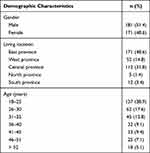 |
Table 1 Demographic Information of the Participants (n=352) |
Regarding the use of the Wateen application, Figure 1 reveals that (57.1%, 201/352) of the participants had used the Wateen application before. Similarly, Figure 2 displays that (45.2%, 159/352) of the respondents knew people who had used the Wateen app previously. The t-tests were conducted considering all the participants (N=352) to identify if there is any difference in the findings between the different participant groups (Table 2). Focusing on the usage of Wateen application, significant difference was observed among the male (N=181, Mean=0.66) and female (N=171, Mean=0.47) participants with t-value = 8.438 and p-value < 0.0001 (p<0.05) at 95% confidence interval. Furthermore, the usage of the application was analyzed between two groups: participants aged 30 or less; and participants aged more than 30 years. Significant difference was observed among the participants aged 30 years or less (N=199, Mean=0.84) and the participants aged more than 30 years (N=153, Mean=0.57) participants with t-value = 12.4585 and p-value < 0.0001 (p<0.05) at 95% confidence interval.
 |
Table 2 T-Tests Results |
 |
Figure 1 Usage of the Wateen App (n=201). |
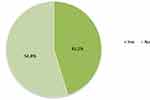 |
Figure 2 Knew people who used the Wateen App (n=159). |
Also, according to Table 3, the participants had used the Wateen app to follow the donation record (35.8%, 72/201), as a reminder of donation dates and campaigns (24.4%, 49/201), find lists and blood bank locations (16.9%, 34/201), request blood donation from the Wateen community (10.0%, 20/201), find donation requests on social media (6.0%, 12/201), and all of the above objectives (7.0%, 14/201).
 |
Table 3 Use of the Wateen App for (N= 201) |
In addition, Table 4 indicates that after receiving the blood donation request from the Wateen app, 85.6% (172/201) of the respondents felt encouraged to donate blood, 10.0% (20/201) of them shared the information with others, 2.5% (5/201) answered “nothing”, and 2.0% (4/201) replied “other”.
 |
Table 4 Response When the Blood Donation Request from the Wateen App Was Received (n=201) |
Similarly, Figure 3 shows that (94.0%, 189/201) of the participants were motivated to donate blood by the Wateen app. Alike, Figure 4 indicates that 81.6% (164/201) of the respondents were educated about the donation process by the Wateen app. As well, Figure 5 illustrates that 30.8% (62/201) of the participants who used the Wateen app indicated that the application helped them to find donors. T-tests were conducted considering all the participants who used Wateen application (N=201) to identify if there are and difference in the findings between the different participant groups (Table 2). Focusing on the motivation of Wateen application for engaging in blood donation, significant difference was observed among the male (N=104, Mean=0.58) and female (N=97, Mean=0.72) participants with t-value = 6.1319 and p-value < 0.0001 (p<0.05) at 95% confidence interval. Furthermore, the results were analyzed between two groups: participants aged 30 or less; and participants aged more than 30 years. Significant difference was observed among the participants aged 30 years or less (N=112, Mean=0.72) and the participants aged more than 30 years (N=89, Mean=0.54) participants with t-value = 4.1819 and p-value < 0.0001 (p<0.05) at 95% confidence interval.
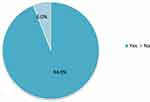 |
Figure 3 Wateen App motivation to donate blood (n=201). |
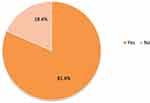 |
Figure 4 Wateen App education about donation (n=201). |
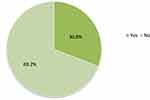 |
Figure 5 Help of the Wateen App to find blood donors (n=201). |
Related to the reduction of the gap between blood donors and the need for blood, Figure 6 shows that 89.1% (179/201) of the respondents stated that the Wateen app had reduced this gap. T-tests were conducted considering all the participants who used Wateen application (N=201) to identify if there are and difference in the findings between the different participant groups (Table 2). Focusing on the education/learning enabled by Wateen application about blood donation, no significant difference was observed among the male (N=104, Mean=0.64) and female (N=97, Mean=0.68) participants with t-value = 0.9318 and p-value =0.3526 (p>0.05) at 95% confidence interval. Furthermore, the results were analyzed between two groups: participants aged 30 or less; and participants aged more than 30 years. No significant difference was observed among the participants aged 30 years or less (N=112, Mean=0.74) and the participants aged more than 30 years (N=89, Mean=0.69) participants with t-value = 1.7292 and p-value = 0.853 (p>0.05) at 95% confidence interval.
 |
Figure 6 Wateen App reduced gap between blood donors and the need for blood (n=201). |
On the other hand, Figure 7 suggests that 48.9% (172/352) of the participants expressed that they had not received or observed a post about the Wateen application on social media networks. Concerning this issue, most of the respondents expressed the following weaknesses of the blood process using the Wateen app:
- The Wateen application needs more advertising on the most powerful social media platforms to increase awareness of the population.
- In the application, there is no way to communicate between the donor and the person who needs the blood.
- Unfortunately, Wateen App does not connect with all hospitals in the Kingdom.
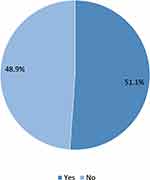 |
Figure 7 Post requests for blood donation through Wateen App on social media (n=352). |
Discussion
Regarding the outcomes of this research on the use of the Wateen app in the blood donation process in Saudi Arabia, it was observed that more than half of the respondents (57.1%) had used the Wateen app. Also, the Wateen app motivated and encouraged most of the participants to donate blood when they received the request for blood donation.
It is argued31 that acceptability of digital health interventions may usefully be considered an emergent property of a complex, adaptive system of interacting components (eg, affective attitude, beliefs), which in turn influences (and is influenced by) user engagement. Accordingly, this study identified that usability and motivation among the participants regarding the Wateen application for blood donation were identified to be satisfactory, though significant differences existed among both genders and different age groups. Young participants were identified to be more motivated and found good usability of the application compared to older patients (Table 2). While male participants found it to have high usability, female participants identified it to be more motivating. Secondly, acceptability is important due to its ability to predict and explain key outcomes of interest, including user engagement and intervention effectiveness. Findings revealed that the participants found the application to be effective for learning about blood donation, which can raise interest and engagement. Finally, precisely what people find acceptable is deeply contextualized and interlinked with prevailing social and cultural norms. The Saudi culture reflects a positive approach for blood donation, indicating the influence of culture on the acceptability of the application.
Since the Wateen app was recently launched by the Ministry of Health (March 2019), the aforementioned results suggested that there was a relatively high acceptance and use of the Wateen app among the participants in Saudi Arabia.23 These results are aligned with the fact that applications can be valuable tools for the blood donation process and are accepted nationally and internationally for this purpose.4–7,11,13,25 Furthermore, we also think that the high acceptance of the Wateen application is because the Arab people consider that blood donation is a humanitarian, noble, and religious activity.14 It is pertinent to mention that, in general, the Arab people have a positive attitude towards blood donation.16–18
Another relevant part of this study was determining what the participants used the Wateen app for. The results described in Table 2, insinuate that a culture about blood donation is being implemented in Saudi Arabia. This culture would increase if the chain of the donation process was smooth and made it easier for donors to follow the donation record, remind them of the date of donation campaigns, list the blood available in nearby donation centers, and facilitate other functions available in the application. It can be suggested that the creation of a blood donation culture in Saudi Arabia is feasible because the Saudi population has a motivating positive approach towards donating blood.14,16–18 Until now, the majority of respondents thought that the Wateen app had narrowed the gap between blood donors and the need for blood.
Based on the results of this study, it would be very helpful to powerfully advertise the Wateen app to a wider audience via social media platforms and other sources. In connection with this comment, Alanzi et al have pointed out that social media platforms can help implement a robust blood donation program in Saudi Arabia that would encourage and motivate people to donate blood.3 Similarly, Abdelgader et al have indicated that there is a high potential for volunteer donors in Saudi Arabia, but proper administrative planning is necessary to ensure that blood banks rely on voluntary donations and fill gaps in the donation system of the Kingdom.26 In the same context, if the Wateen app were linked or connected to government apps like Absher, Saudi citizens who are eligible to donate blood would be more aware of the potential of this app for donation purposes.27 Furthermore, studies31,32 observed that eHealth interventions can be adopted in times of health emergency, as a convenient, safe, scalable, effective, and green method of providing clinical care. In this regard, since the Wateen app is a national app endorsed and launched by the Saudi Arabian Ministry of Health, it must be connected to all public and private hospitals. By incorporating the above-mentioned requirements into the blood donation process in Saudi Arabia, the Wateen app would be a potentially valuable tool in promoting blood donation to a high proportion of the population of this country. However, there are few issue identified in this study, which include poor advertising, communication issues on the application, and lack of connectivity of the application with all hospitals. Accordingly, the reviews in the play store33 indicated few negative reviews and poor rating (2.1/5) for the Wateen application. Considering these factors, it is important for the developers (Ministry of Health) to address the technical issues in the application and improve its usability by linking the application with all major hospitals across the country to simplify the blood donation process.
Conclusion
The results of this research indicated that there is a general acceptance of the use of the Wateen app among the participants in this study. Based on the findings, this study can have various practical implications. Firstly, it allows the decision-makers (Ministry of Health) in evaluating the application and making necessary improvements to it. Secondly, in evaluating the participants’ usability aspects analyzed by the demographic characteristics, necessary decisions can be made in order to increase the usability among the targeted population. Furthermore, the findings also help the decision-makers in understanding the various issues associated with the application such as technical/usability issues and address them for increasing the usability.
The main limitations of this study were related to the fact that the questionnaire was conducted online, which resulted in a limited number of participants. In addition, limited time and resources also posed a challenge. Furthermore, no studies related to the acceptability of blood donation applications by blood donors and requesters were found in the literature. This fact restricted our discussion because we were unable to compare the results of this research with other studies related to the acceptability of blood donation apps.
While the stated limitations have no impact in terms of nullifying the results observed in this investigation, future studies will be addressed to minimize these limitations. Also, it would be interesting to study the barriers to using the Wateen app. Furthermore, it would be important to compare the Wateen app with other apps available around the world, including apps accessible on Google Play and Apple app stores. Future research may focus on addressing these limitations, develop strategies for increasing the use of eHealth interventions such as Wateen for various healthcare needs and evaluate them.
Acknowledgments
We thank Mr. Aqeel Al Otaibi of John Hopkins Aramco Healthcare, the blood bank laboratory at King Fahad Specialist Hospital, and Ms. Atheer Al Otaibi for their help in facilitating the data collection.
Disclosure
The authors report no conflicts of interest in this work.
References
1. Ouhbi S, Fernández-Alemán J, Toval A, et al. Free blood donation mobile applications. J Med Syst. 2015;39:52. doi:10.1007/s10916-015-0228-0
2. World Health Organization. Blood safety and availability. Available from: https://www.who.int/news-room/fact-sheets/detail/blood-safety-and-availability.
3. Alanzi T, Alsaeed B. Use of social media in the blood donation process in Saudi Arabia. J Blood Med. 2019;10:417–423. doi:10.2147/JBM.S217950
4. Blood App. American red cross; 2016. Available from: http://www.redcrossblood.org/bloodapp.
5. Fahim M, Cebe H, Rasheed J, et al. MHealth: blood donation application using android smartphone.
6. Jenipha T, Backiyalakshmi R. Android blood donor life saving application in cloud computing. Biom Bioinf. 2014;6(1):34–36.
7. Google. Blood donor finder; 2016. Available from: https://play.google.com/store/apps/details?id=com.Neologix.BloodDonorFinder&hl=en.
8. Siromani U, Thasian T, Isaac R, et al. WhatsApp: a new tool for recruitment and retention of voluntary blood donors. Int J Adv Med Health Res. 2015;2(1):72. doi:10.4103/2349-4220.159176
9. Yuan S, Chang S, Uyeno K, et al. Blood donation mobile applications: are donors ready? Transfusion. 2016;56(3):614–621. doi:10.1111/trf.13387
10. Abbasi R, Maqbool O, Mubashar M. Saving lives using social media: analysis of the role of twitter for personal blood donation requests and dissemination. Telematics Inf. 2020;35:892–912.
11. The NHS Give Blood App. Available from: https://www.blood.co.uk/the-donation-process/the-nhs-give-blood-app/.
12. Sümnig A, Feig M, Greinacher A, et al. The role of social media for blood donor motivation and recruitment. Transfusion. 2018;58(10):2257–2259. doi:10.1111/trf.14823
13. Tatikonda V, El-Ocla H. BLOODR: blood donor and requester mobile application. mHealth. 2017;3:40. doi:10.21037/mhealth.2017.08.08
14. Abdel Gader A, Osman A, Al Gahtani F, et al. Attitude to blood donation in Saudi Arabia. Asian J Transfus Sci. 2011;5(2):121–126. doi:10.4103/0973-6247.83235
15. Abolfotouh M, Al-Assiri M, Al-Omani M. Public awareness of blood donation in Central Saudi Arabia. Int J Gen Med. 2014;7:401–410. doi:10.2147/IJGM.S67187
16. Al‐Johar A, Al‐Saud A, Abalkhail Y, et al. Why do Saudi women refrain donating their blood? A study on the attitude, belief and motivation of Saudi female university students towards blood donation. Clin Lab. 2016;62:771–779. doi:10.7754/Clin.Lab.2015.150718
17. Al-Faris A, Bahabri A, Abdullah A, et al. Attitude to blood donation among male students at King Saud University. J Appl Hematol. 2013;4:70–77.
18. Share of people who agree that they frequently give blood to help others in Saudi Arabia as of May 2018. Available from: https://www.statista.com/statistics/917703/saudi-arabia-attitudes-towards-blood-donation/.
19. Mann M, Votto J, Kambe J, et al. Management of the severely anemic patient who refuses transfusion: lessons learned during the care of a Jehovah’s Witness. Ann Intern Med. 1992;117(12):1042–1048. doi:10.7326/0003-4819-117-12-1042
20. Rosengart T, Helm R, DeBoiss W, et al. Open heart operations without transfusion using a multimodality blood conservation strategy in 50 Jehovah’s Witness patients: implications for a “bloodless” surgical technique. J Am Coll Surg. 1997;184(6):618–629.
21. Okpara R. Attitudes of Nigerians towards blood donation and blood transfusion. Trop Geogr Med. 1989;41(1):89–93.
22. SaudiGazette. Health Ministry launches blood donation app. SaudiGazette. Available from: http://saudigazette.com.sa/article/561386/SAUDI-ARABIA/Health-Ministry-launches-blood-donation-app.
23. MOH. MOH launches «Wateen» blood donation app; 2019. Available from: https://www.moh.gov.sa/en/Ministry/MediaCenter/News/Pages/news-2019-03-14-001.aspx.
24. Kfshrc. Wateen application; 2019. Available from: https://www.kfshrc.edu.sa/en/home/patientcare/patientsvisitorsinformation/4990.
25. Ahmed A, Christensen L. Improving and supporting blood donation practices in Khartoum Sudan blood banks through android mobile app and web application system. Int J Comput Sci Trends Technol. 2019;7(2):83–92.
26. Abdelgader A, Al Ghumkas A. The future of voluntary blood donation in the Kingdom of Saudi Arabia. Transfusion. 2020;60(1):28–34. doi:10.1111/trf.15683
27. 18m used Saudi Arabia’s Absher services last year. Available from: https://www.arabnews.com/node/1774491/saudi-arabia.
28. Woolson R, Bean J, Rojas P. Sample size for case-control studies using cochran’s statistic. Biometrics. 1986;42(4):927–932. doi:10.2307/2530706
29. Shadish WR, Cook TD, Campbell DT. Experimental and quasi-experimental designs for generalized causal inference. Cengage Learning: Boston, MA; 2002.
30. QuestionPro. Free online survey software and tools | questionPro® [Internet]. Questionpro.com; 2021 [
31. Anthony B
32. Bokolo A. Application of telemedicine and eHealth technology for clinical services in response to COVID‑19 pandemic. Health Technol. 2021;11(2):359–366. doi:10.1007/s12553-020-00516-4
33. Google Inc. Wateen [Internet]. Play.google.com; 2021 [
 © 2021 The Author(s). This work is published and licensed by Dove Medical Press Limited. The full terms of this license are available at https://www.dovepress.com/terms.php and incorporate the Creative Commons Attribution - Non Commercial (unported, v3.0) License.
By accessing the work you hereby accept the Terms. Non-commercial uses of the work are permitted without any further permission from Dove Medical Press Limited, provided the work is properly attributed. For permission for commercial use of this work, please see paragraphs 4.2 and 5 of our Terms.
© 2021 The Author(s). This work is published and licensed by Dove Medical Press Limited. The full terms of this license are available at https://www.dovepress.com/terms.php and incorporate the Creative Commons Attribution - Non Commercial (unported, v3.0) License.
By accessing the work you hereby accept the Terms. Non-commercial uses of the work are permitted without any further permission from Dove Medical Press Limited, provided the work is properly attributed. For permission for commercial use of this work, please see paragraphs 4.2 and 5 of our Terms.

